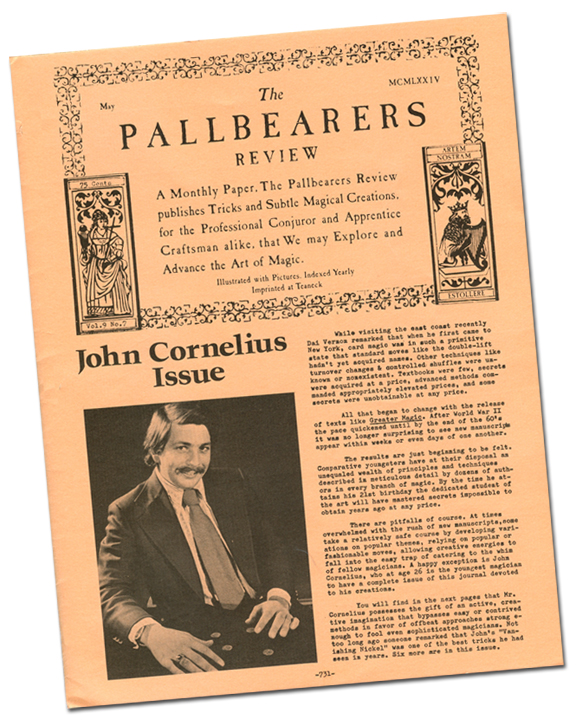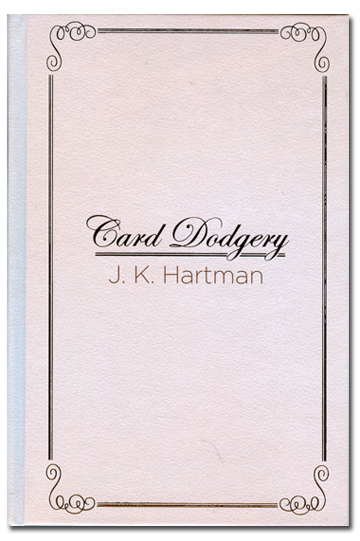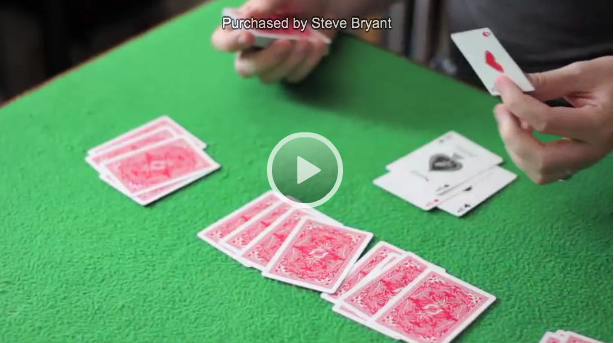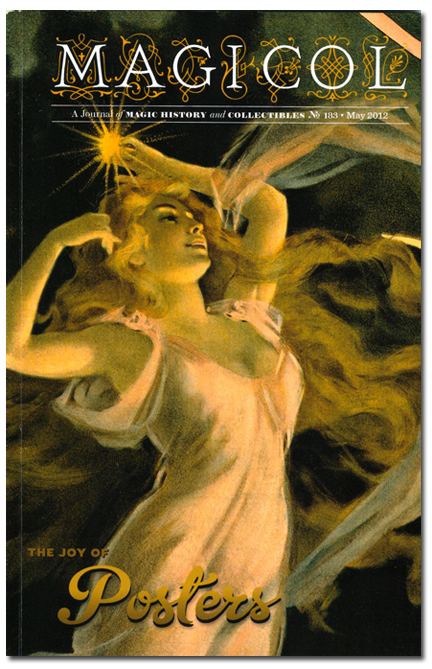
|
Note ye ed's email address: stevebryant99@gmail.com. |


A first look at John Cornelius.
|
In case you missed it, check out last month's special issue on Abbott's 75th Get-Together, featuring awesome photos by David Linsell. |
September 2012 This month, thanks to a new book and an old one, we journey back to the wonderful days in which my mailbox was frequented by new issues of The Pallbearers Review and Epilogue. Two of the magazines' most valued contributors were J.K. Hartman and John Cornelius, and anything I read by them transports me back to those happy days in which I always looked forward to the mailman's arrival. The new book is Hartman's Card Dodgery, purportedly his swan song volume, but I hope not. The old book is The Award-Winning Magic of John Cornelius by Lance Pierce, appearing in new format on my iPad thanks to the L&L decision to republish all its hardbacks as e-books. Its previous physical incarnation somehow escaped my ravenous hunger for magic books, and it's a delightful find. Few sources send us on journeys to the past as do magic posters, the subject of a special issue of Magicol, "A Journal of Magic History and Collectibles" published by David Ben's Magicana. This issue they hit out of the park. It's just beautiful, and I hope you are a subscriber. That's it, a month to kiss summer goodbye and to rest up with a couple of good books. I hope to see you all at next month's Genii bash. |
|
|
ARTFUL DODGERY-- Vanishing Inc. continues to impress with its classy product line. The latest example to cross my desk is Card Dodgery, a dense volume of new card tricks (60 tricks, 300 pages, 350 illustrations) from J.K. Hartman. The book is handsomely laid out by Andi Gladwin, handsomely illustrated by Tony Dunn (though, given that it's Hartman, I miss the softer style of Joseph K. Schmidt), with an introduction by Hartman and forewords by Bill Goodwin and Gordon Bean. My bookshelf already strains under the weight of previous Hartman hardbacks (namely Card Craft, After Craft, Trickey Treats, Card Dupery, and Caan Craft). and the new collection is a worthy addition.  Sixty card tricks. J.K. Hartman sort of burst onto the scene in the Fulves publications, and, as he reveals in the book's candid closing interview, he had about twenty years of material ready when he first started corresponding with Fulves. What a delightful intersection of interests. As Fulves put it, J.K. Hartman made an immediate impression on the attention of insiders: "His grasp of the principles of card magic, coupled with an intelligent, incisive style of writing, has made his manuscripts among the most well-received on the contemporary scene." I'll mention a few routines that excited me. In Carlo Monte, the spec cuts a deck into four random piles. A queen is dropped upon one of the piles, and the piles are switched about, the spec's job being to follow the queen. He fails. A second spec finally succeeds, and all four top cards are shown to be aces. Class Cut II proceeds from John Bannon's Directed Verdict, but all four cuts look the same. (It's a Spec Cuts to the Aces, also perfect for my Return to Motel 666.) Guess Star begins with a spec sliding a card from a spread. Both she and the magi guess its value. Running through the deck, magi finds his card, hence he failed. The card on the table turns out to be the card she named. (Note: the deck is ordinary and shuffled, spec's choice is fair. But, hmm, if you force the card on her, forcing a duplicate of the card you name, you can make the ending look very clean.) Suito Psychometry is the familiar Annemann routine but with playing cards as the items in the envelopes. There are some very clever ideas here that would work with any psychometry routine. 4'11 is an ace assembly with a great patter tie-in, long a Hartman hallmark. Trap Rap takes almost any sandwich routine to a new level. This may be the most important set of ideas in the book. Garden of Eaten is a cannibal routine in which three "tourists" are eaten. A very different method from that usually employed. I Think I.C.A.A.N. is, as with most of the tricks in this book, a great title. J.K. Hartman has produced more performable Card at Any Number plots than anyone I know, and I love this one. The I stands for invisible. Any card named turns invisible then reappears at any number named. Position Possesion is another C.A.A.N.: a named card is placed, outjogged, deep in the deck, and a lower numbered location (any location) is shown to be another card. The outjogged card is pushed flush and then rediscovered at the lower numbered location. Suggestion Box begins with five aces of spades and ends with a royal flush. Note: I would always do a Vallarino count somewhere in such an effect. Johns & Jills is another Hotel Mystery, of which I am a longtime fan. My favorite title over the years was Hartman's Flatfoot, Floozie, and the Boy-Boy, whose patter is used somewhat in this one. Enough! I was going to mention only five, but you get the idea. $40 anywhere, but if you order from Vanishing Inc. you get a signed copy and a download of Andi performing and explaining nine of the routines.  Andi Gladwin explains Piano Forte. (Final note: Okay, I'll mention one more. I didn't watch Andi's explanations until I had finished reading the book. I had skipped Piano Forte in my first reading, and Andi just killed me with it. A brilliant self-working poker deal, highly recommended.) |
|
|
HOW TO BE FANTASTIC WITH ONLY FIVE CENTS -- It all started with a nickel. The second golden age of magic, for me anyway, began with Doug Henning's first television special, a live show that opened with the bare hand vanish of a nickel. It was of course John Cornelius's Fickle Nickel, and, like most of John's material, featured a completely outside the box method. It was a particularly productive period for John Cornelius, the youngest inventor to have his own one-man issue of Pallbearers, and the best of John's material, including individually marketed effects, was eventually collected in a 194-page hardback, The Award-Winning Magic of John Cornelius by Lance Pierce. (Lance also wrote Roger Klause In Concert and was a most helpful proofreader on The Little Egypt Book of Ghosts.) The nicely designed book came out in 2001, but it has an older feel because many of the photos are of an earlier era, when both John and Doug Henning wore frilly dress shirts and David Copperfield had yet to settle on a workable hairstyle. Lance wrote the book in a breezy prose style which I enjoyed: Years ago, when the masters were young, Ace assemblies were the rage. Vernon and Miller concocted several wonderful versions of the "slow-motion" assembly plot, "Mac" MacDonald performed his destined-to-be-classic MacDonald's Aces, and Bob Stencel's underground handling (not released until almost thirty years later!) amazed and confounded. Although I missed the book when it first appeared (inexplicably, as I was always a Cornelius fan), I recently had the pleasure of acquiring and reading it in e-book format. In what is surely the wave of the future, L&L Publishing is realeasing all of its books in that format, and I love the option of carrying favorites with me on my iPad. The e-book version of the Cornelius book is $22.95, and I acquired it for a monthly special of $9.95! Check out Louis's ads.  A close-up look at John Cornelius on an iPad. It's a pot pourri of material, with a pocket ruse, a cigarette vanish, a cigarette production, flash paper effects, bill and coin magic, vanishes with the pendulum principle, magic with ladies' finger rings, a shrinking card case, and off the wall uses for a baby bottle nipple, business cards with raised lettering, a watchband, and a super ball. And, of course, card tricks. A few to illustrate: An Assembly of Silver is a Matrix-type coin trick in which Lance explains the subtle differences between Matrix routines and Sympathetic Coins routines. Bluff Poker, with minor additions by John Cornelius, has its basis in Marlo's Bluff Slow-Motion Four Aces. I finally learned the trick when Bill Malone fooled me with it on the Malone/Marlo DVDs, but I wish I had learned it much earlier from John. Whatever, it immediately became my favorite way to do the Slow-Motion Four Aces. KnotSoTuff is the book's title for what most know as John Cornelius's Sliding Knot, which I first read in Apocalypse. A sort of close-up impromptu version of Paul Curry's Sliding Knot, this is a rather beautiful rope trick that I used to feature in standup shows way back when. Passages is a group of effects (impossible card tricks, drink productions, whatever) made possible with a slit in the performer's jacket. These are truly sensational. The F.I.S.M. Act, also known as "Every Card Trick in the World in Ten Minutes," won John first-place awards at two FISMs, and it's all here if you are ambitious enough to learn it. The John Cornelius Card System is my favorite in this book, my favorite in several books recently. It's a stack that gives you the name of the card for any suggested location. If you say 38, I know the card is the jack of diamonds. It's a really simple calculation, not a memorized deck, and the system comes with a convincing three-card revelation that uses the stack. Very nice! |
|
|
THE PAPER CHASE -- The Magic Collectors Association is an organization of fine fellows who collect anything magical but whose serious money, when you get down to it, goes to collecting posters, those lovely wall-filling artworks that advertised magic shows from the 1880s through the early 1900s, the best coming out of the Strobridge Lithographic Company of Cincinnati, Ohio. These same fine fellows also subscribe to a digest-size quarterly magazine called Magicol (for various legal reasons, an offshoot of David Ben's Magicana rather than off the MCA), whose May 2012 issue was devoted to The Joy of Posters.  Posters to die for. This issue turned out to be so beautiful that it deserves recognition. Following an opening history of poster collection by Mario Carrandi (originally written in 1976), editor David Ben ran the most beautiful section, the favorite posters of several prominent collectors. Each could nominate only one poster, and it was a thrill to see those reproduced in full color, the personal favorites of Charles Geeene III, Gabe Fajuri, Mario Carrandi, Mike Caveney, Norm and Lupe Nielsen, Bruce Averbook,Tad Ware, Ken Trombly, David Ben, Julie Eng, and David Stahl. I especially liked David Stahl's Herrmann Maid of the Moon poster, which also earned a spot on the cover. Charles Greene III and Pietro Micheli added articles on poster preservation, and David Ben wrote a most interesting piece on the metrics of assigning a dollar value to collectible magic art. In addition to other news and reviews, Dustin Stinett provided a fourteen-page review of the 43rd Magic Collectors Weekend, held last May to honor Richard Kaufman and James Hagy. This too was beautiful, with numerous half-page and full-page photos. It's difficult to illustrate anything in a digest-size journal, and this issue is a case study in how to do it right. (You can subscribe here.) |
|
See you at Walt Disney World!
Little Egypt Magic is the erratically updated web site of Steve Bryant, spawned (the site, not Steve) by a former internet magazine known as The Little Egypt Gazette/for magicians only. Steve Bryant is an obscure magician and writer who generates this site from an iMac in Bloomington, Indiana. He frequently journeys to and performs magic in Little Egypt, the local name for extreme southern Illinois, where the towns bear such names as Cairo, Thebes, and Karnak. Past issues of this web site: Index to Past Issues Notice: Any limited use of copyrighted images or quoted text is considered fair use, usually to review whatever product or event that is under discussion. If you object to use of any material, please get in touch and it will be cheerfully removed. |
A JSB Creations product
Copyright© 2012 by Steve Bryant